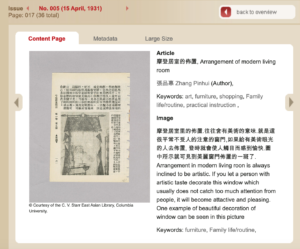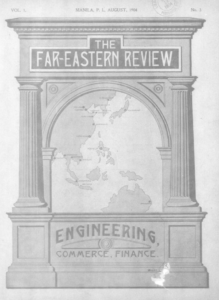The working title of my long essay is ‘Currents of Resistance? The Upheaval of Nationalist Space During the 1931 China Floods’. I aim to evaluate the effects of natural disaster on the population of Wuhan, following the flood of the Yangtze River Valley area in 1931. The floods and their destruction of traditional spatial boundaries had several implications for the dissemination of nationalist authority and its reception by the Chinese population.
I initially explored how spaces of authority, such as public squares, statues, and government offices were physically submerged in water and left to stagnate. This removed symbolic markers of political and class authority and left the inhabitants of Wuhan treading the same water for survival. The Yangtze Valley was transformed into a flat plain where the water disrupted the hierarchical arrangement of space and left the Kuomintang government to reconstruct the physical markers of their legitimacy. The Hankow Herald published a ‘Flood Relief Edition’, in which one item describes the government’s attempts to restore railway lines and electrical plants.[1] The flood had the ability to physically remove markers of technological progress and modernity from the Chinese landscape and the restoration of these amounted to a restructuring of Republican authority as they accepted help from international parties and attempted to alleviate their responsibility for the disaster. Additional sources, such as the missionary journal, China’s Millions have been instrumental in understanding the interaction of Western and Chinese spatial practices in the reconstruction of Wuhan’s physical landscape.[2]
Whilst this approach was valuable in my initial research, I wanted to look at the floods from the perspective of those who they affected the most; the poorer, local, Chinese population. Through research guided by Chris Courtney’s The Nature of Disaster, I have found that it was not only the initial force of natural disaster which challenged the Kuomintang.[3] Relief efforts, in tandem with international aid, met with resistance from locals and refugees who had been dislocated from their homes after the devastating impact of the floods. This is reported in the case of famous aviator, Charles Lindbergh, who attempted to deliver medicine, instead of food, to starving refugees. Lindbergh dealt poorly with the anticipation of the Chinese people, who discarded the medicine as it had no immediate or tangible effects on their suffering. [4] Mistrust of government officials and foreign missionaries was prompted by this mismatch between official policy and lived experiences of the refugees. From a perspective of spatial theory, the refusal of aid often amounted to spatial resistance, where refugees sought to either retain or reinvent the memory of home rather than being shipped off to government camps. In doing so, they claimed the environment of the floods for themselves, rather than submitting their home to the government’s remedial intervention. The Hankow Herald Flood Edition reports that homes were constructed in trees or on top of hills as a reaction against human transportation to government camps.[5] Seemingly, no matter how unrecognisable home may have become, the emotional and physical attachment to the environment was a means of empowerment against the culpable government. In addition, disparaging and impatient state newspaper reports on the increase of sampan boats reveal another form of spatial resistance.[6] These locally constructed boats were the most efficient way to navigate the flood waters, and were a means of generating monetary profit, but also established autonomy over government aid workers who were forced to adopt this traditional means of transport in order to navigate the flood waters. The Yangtze flood plain was visually dominated by the sampan boat- a symbol of local autonomy against the parallel threat to home of both natural disaster and the Kuomintang.
National and international aid did of course help mitigate the economic and social impact of natural disaster. However, I aim to further investigate reports of the 1931 floods which suggest that the Kuomintang met with resistance to their efforts to reconstruct the nation. Using a variety of primary sources, I aim to chart how the flood destroyed politically determined boundaries and analyse how this granted Chinese inhabitants a level of autonomy over the Kuomintang. Chris Courtney’s accounts of refugee’s construction of makeshift homes, promotion of the traditional sampan and enactment of traditional practices within the temporary home environment of the refugee camp will be a useful support to primary resources, alongside other secondary literature.
Bibliography
Primary Sources
‘The Flood in Kiangsu’, China’s Millions, London, 1931, pp.228-231.
‘Flood Relief Edition’, Hankow Herald, Hankow, 1931.
North China Herald, Vol. 1931, No. 3342, Shanghai, 25 August 1931.
North China Herald, Vol. 1931, No. 3344, Shanghai, 08 September 1931.
North China Herald, Vol. 1931, No. 3345, Shanghai, 15 September 1931.
‘Govt Not Responsible for Floods’, Singapore Standard, Singapore, 7 November 1950, p.4.
‘South China Floods’, The Singapore Free Press and Mercantile Adviser, Singapore, 6 July 1931, p.11.
‘The China Floods’, The Singapore Free Press and Mercantile Adviser, Singapore, 22 October 1908, p.16.
‘Floods in China’, The Singapore Free Press and Mercantile Adviser, Singapore, 19 October 1917, p.10.
Select Secondary Sources
Courtney, Chris, The Nature of Disaster, (Cambridge 2018).
Li, Lillian, Fighting Famine in North China: State, Market and Environmental Decline 1690s-1990s, (Stanford 2007).
Pietz, David, Engineering the State: The Huai River and Reconstruction in Nationalist China, 1927-37, (2002).
[1] ‘Flood Relief Edition’, Hankow Herald, Hankow, 5 September 1931, p.1.
[2] ‘The Flood in Kiangsu’, China’s Millions, London, 1931, pp.228-231.
[3] Chris Courtney, The Nature of Disaster, (Cambridge 2018).
[4] Chris Courtney, The Nature of Disaster, (Cambridge 2018), pp.153-155.
[5] ‘Flood Relief Edition’, Hankow Herald, Hankow, 18 August 1931, p.2.
[6] ‘South China Floods’, The Singapore Free Press and Mercantile Adviser, Singapore, 6 July 1931, p.11.





